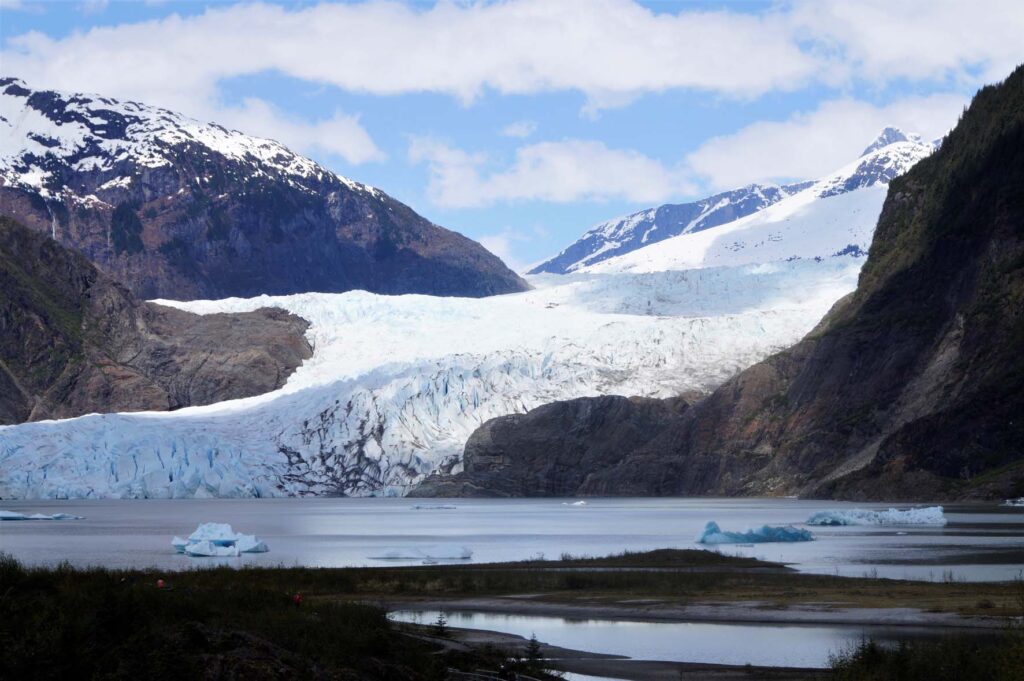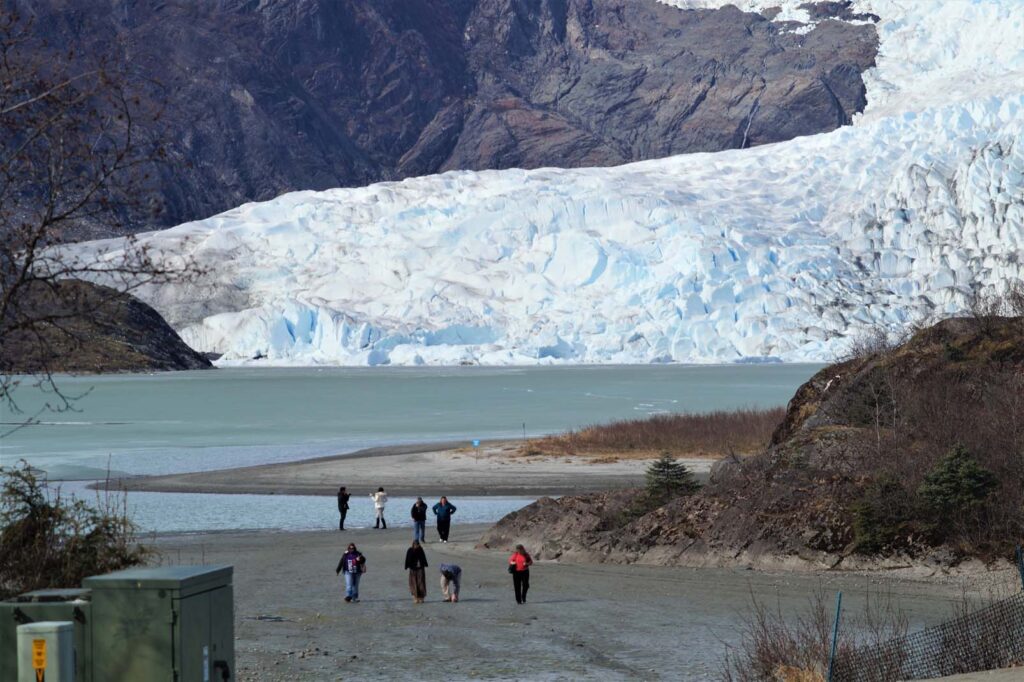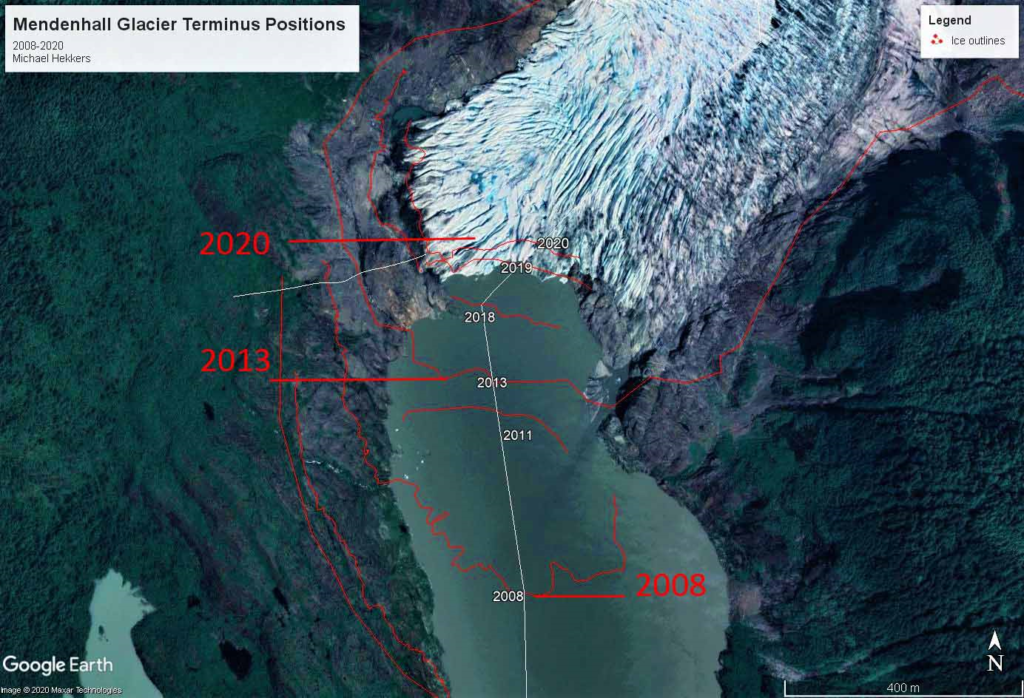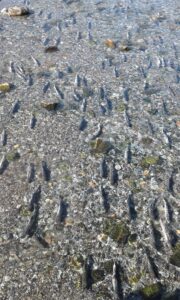Needless to say, seeing my first glacier in Juneau, Alaska in 2013 left me in awe and slack-jawed. It is a vivid memory; an imposing valley glacier glistening white with a topaz blue terminus, cradled between craggy, yet majestic, snow-capped peaks.

An interpretive guide for Gastineau Guiding Company, I lead Mendenhall Glacier viewing excursions through the Mendenhall Recreation Area (MRA) within the utterly spectacular Tongass National Forest. After 400+ trips, I am still in awe of the mighty Mendenhall, but my awe is tainted by the glacier’s rapid retreat. In fact, the U.S. Forest Service’s (USFS) anticipates the Mendenhall Glacier may be out of sight from the MRAs’ visitor center by 2050.
Check out the Extreme Ice Survey’s video documenting the Mendenhall’s extreme retreat between 2007 and 2014. Check out Google Earth’s Mendenhall recession timeline, 1984-2016.

Although many of my guests are disheartened, if only temporarily, to learn the glacier is receding, I frame this phenomenon in a positive light by sharing my excursion theme of Glacial Recession Sprouts Forest Succession. “As glaciers retreat, new ecosystems emerge,” I explain. “The process, however, can take 300 years from lichens on bare rock to a mature forest of Western Hemlocks and Sitka Spruce.”
Addressing global warming’s impacts on Alaska, however, is a slippery slope. I lead with softball questions to gauge guests’ attitudes on the climate phenomena. Inevitably, there are individuals who believe global warming is normal and has nothing to do with fossil fuel emissions. Some naysayers are open to hearing my facts, my opinion. Some shutdown. Some want to engage in a vigorous debate. Depending on my guests’ mindsets, I may delve further into the causes and consequences of a warmer planet or delicately change the subject. Because my excursions are six hours there are opportunities to respectfully engage one-on-one should a guest want to.
My theme for addressing the negative impacts of the Mendenhall’s recession is: Many aquatic species in Alaska require glacial runoff to survive. I gleaned this theme from the United States Geological Survey’s (USGS) website. I lean on the authority of the USGS and the National Oceanic and Atmospheric Administration (NOAA) to back up my global warming statements.

“Continual melt from glaciers contributes…perennial stream habitat and a water source for plants and animals,” states the USGS’ website. “The cold runoff from glaciers also affects downstream water temperatures. Some aquatic insects–fundamental components of the food web–are especially sensitive to stream temperature and cannot survive without the cooling effects of glacial meltwater.”

A keystone species, salmon also require deep, glacier cooled waterways to survive to spawn. For salmon eggs and juveniles, warm, shallow streams, creeks and rivers make them vulnerable to predation and oxygen deprivation. Like aquatic insects, fewer salmon stresses the forest’s food web. According to Alaska’s Wild Salmon, an Alaska Department of Fish and Game publication, many species depend on salmon to survive, including orcas, bears, birds and humans. Hey, there is another of my secondary themes: 130 Alaskan species depend on salmon to survive and thrive.
It is good to know future MRA visitors and wildlife will benefit from the USFS forward thinking plan, but honestly, I am not optimistic about the long-term prospects for glaciers worldwide.
***
Want to know more about receding and collapsing glaciers?
Check out Chasing Ice, available on Netflix and Amazon Prime or
Chasing Ice Producer James Balog’s TED Talk.

The map is a great tool in illustrating the changes over the years.
I took this tour with Aleta who is a very solid naturalist and made it a memorable trip.
A good in depth view of the retreat of the glacier. I have seen the Mendenhall myself.
A nice blog for nature enthusiasts!
Thank you John, Nature shifts and changes to meet a need.
I like the way you step back from the immediate, threatening future, and point out that it’s really just part of an ongoing process. Kudos!